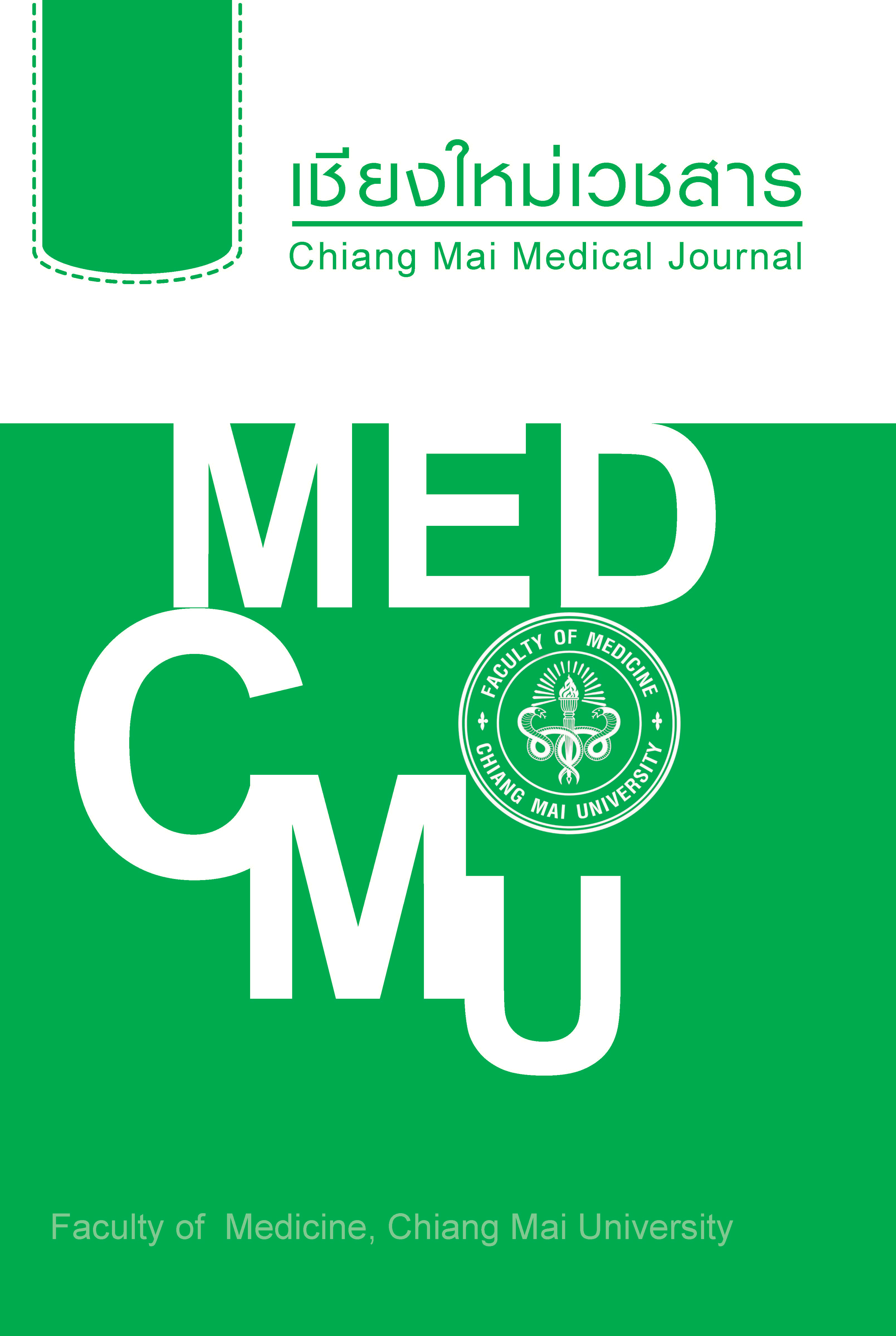Effectiveness of the rhabdomyolysis treatment protocol in critically ill trauma patients at the level I trauma center
Main Article Content
Abstract
Objective Rhabdomyolysis and its consequence, acute renal failure, is a serious complication with high mortality rate. However, its treatment differs among individual physicians. Therefore, the rhabdomyolysis treatment protocol was established by the multidisciplinary experts’ consensus in July 2008. The objective of this study was to evaluate the effectiveness of the rhabdomyolysis treatment protocol after implementation in critically ill trauma patients.
Material and methods A retrospective chart review on rhabdomyolysis patients was performed between 1st January 2006 and 31thDecember 2010, and de fi ned as total creatine phosphokinase (CK) of more than 3,000 U/L. The patients admitted before and after July 2008 were de fi ned as the pre- and post- protocol group, respectively. The demographic data, disease severity, fl uid administration, and outcomes were recorded. Statistical signi fi cance was de fi ned as p<0.05.
Results A total of 659 patients was admitted into this study, with investigation of CK being made during the study period. Of these patients, 267 had rhabdomyolysis (29 and 238 in the pre- and post-protocol group, respectively). There was a statistically signi fi cant difference in the occurrence of acute kidney injury (pre-protocol group vs. post-protocol group: 51.7% vs. 29.4%; p=0.015), and acute dialysis requirement (13.8% vs. 3.6%, p=0.01). The mortality rate of patients requiring long term dialysis, and the creatinine level at discharge were no different between the two groups. Mixed model analysis of the clinical and laboratory parameter, during 14 days of admission, showed a signi fi cant decrease of CK (p<0.001), decrease of creatinine (p<0.001), higher urine pH monitoring (p=0.005), less mannitol administration (p<0.001), and higher administration of sodium bicarbonate (p=0.006) in the post-protocol group
Conclusion The rhabdomyolysis treatment protocol is effective in terms of acute renal failure, acute dialysis, and decreasing CK and serum creatinine level in rhabdomyolysis post-trauma patients. Limitation This was a retrospective study. The data recorded in the pre-protocol period were incomplete, and the CK was not investigated routinely during this time.
Article Details

This work is licensed under a Creative Commons Attribution 4.0 International License.
References
Huerta-Alardin AL, Varon J, Marik PE. Bench-to-bedside review: Rhabdomyolysis--an overview for clinicians. Crit Care 2005;9:158-69.
Slater MS, Mullins RJ. Rhabdomyolysis and my-oglobinuric renal failure in trauma and surgical pa-tients: a review. J Am Coll Surg 1998;186:693-716.
Malinoski DJ, Slater MS, Mullins RJ. Crush injury and rhabdomyolysis. Crit Care Clin 2004;20:171-92.
Vanholder R, Sever MS, Erek E, Lameire N.Rhabdomyolysis. J Am Soc Nephrol 2000;11:1553-61.
Gabow PA, Kaehny WD, Kelleher SP. The spectrum of rhabdomyolysis. Medicine (Baltimore) 1982;61:141-52.
Bagley WH, Yang H, Shah KH. Rhabdomyolysis. Intern Emerg Med 2007;2:210-8.
Basnayake K, Cockwell P, Hutchison CA.Rhabdomyolysis and acute kidney injury. N Engl J Med 2009;361:1411-2; author reply 2-3.
Gonzalez D. Crush syndrome. Crit Care Med 2005;33:S34-41.
Bywaters EG, Beall D. Crush Injuries with Impair-ment of Renal Function. Br Med J 1941;1:427-32.
Bosch X, Poch E, Grau JM. Rhabdomyolysis and acute kidney injury. N Engl J Med 2009;361:62-72.
Brown CV, Rhee P, Chan L, Evans K, Demetria-des D, Velmahos GC. Preventing renal failure in patients with rhabdomyolysis: do bicarbonate and mannitol make a difference? J Trauma 2004;56:1191-6.
Morris JA, Jr, Mucha P, Jr, Ross SE, et al. Acute posttraumatic renal failure: a multicenter perspec-tive. J Trauma 1991;31:1584-90.
Vivino G, Antonelli M, Moro ML, et al. Risk fac-tors for acute renal failure in trauma patients. In-tensive Care Med 1998;24:808-14.
Ron D, Taitelman U, Michaelson M, Bar-Jo-seph G, Bursztein S, Better OS. Prevention of acute renal failure in traumatic rhabdomyolysis. Arch Intern Med 1984;144:277-80.
Knochel JP, Moore GE. Rhabdomyolysis in Ma-laria. N Engl J Med 1993;329:1206-7.
Knottenbelt JD. Traumatic rhabdomyolysis from severe beating--experience of volume diuresis in 200 patients. J Trauma 1994;37:214-9.
Bellomo R, Ronco C, Kellum JA, Mehta RL, Pa-levsky P. Acute Dialysis Quality Initiative w. Acute renal failure - defi nition, outcome measures, ani-mal models, fl uid therapy and information technol-ogy needs: the Second International Consensus Conference of the Acute Dialysis Quality Initiative (ADQI) Group. Crit Care 2004;8:R204-12.
Levin A, Warnock DG, Mehta RL, et al. Acute Kidney Injury Network Working G. Improving out-comes from acute kidney injury: report of an initia-tive. Am J Kidney Dis 2007;50:1-4.
Kidney Disease Improving Global Outcomes (KDIGO): Acute Kidney Injury Work Group.KDIGO Clinical Practice Guideline for Acute Kid-ney Injury. Kidney Int Suppl 2012;2:8-12


